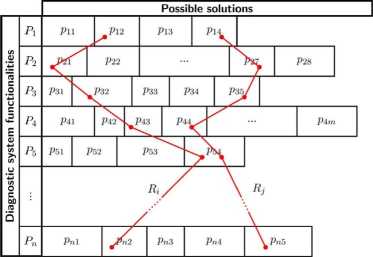7696081870
Diagnostyka - Applied Structural Health, Usage and Condition Monitoring' 3(63)/2012 Cholewa, Amarowicz, Management Of Reąuirements For Developed Diagnostic Systems

Fig. 1. Morphological table as a set of possible Solutions
The size of a designed table depends on characteristics of an object that the system is developed for (number of rows) as well as diagnostic methods and techniques (row elements).
i* i>
As shown in Fig. 1, specific Solutions (“ft**/) are developed in the fonn of a coinbination of selected Solutions for meeting particular goals. In a generic case, it is then possible to develop a set of
n«ird(fFj),3
> (i)
diagnostic system Solutions, where card(P() js the number of Solutions capable of meeting the goal i (i.e. the number of elements in the row i). Initially, the set of Solutions may comprise inefficient Solutions as well unrealizable Solutions. They will be eliminated in subseąuent steps of the development process. The application of a morphological table guarantees tlie considering of all Solutions. The process of selecting an ultimate solution out of the solution set is an optimization task and that of a multicriterial optimization in particular.
2. REQUIREMENT ENGINEERING
Requirement based procedures are often used in the area of software engineering. For example, various literaturę sources [10,13,15,16] have proposed defmitions of the term „reąuirement” in the software engineering aspect. In generał, it is assumed that a requirement is a statement describing functions that a specific solution should meet. One
example of a requirement for a condition monitoring (diagnostic) system project can be the following statement: „relative displacement amplitudę
measurement in the bearing node no. 4 in the rangę from XX to YY at the accuracy of ZZ
One field of science to consider and examine all requirement related aspects is requirement engineering, and its fundamental tasks are revealed in Fig. 2.
2.1. Defining requirements
Defining requirements comprises four fundamental processes, i.e., acquisition, analysis, specification, and verification.
The purpose of the acquisition process is to discover or reveal, emphasize, and to present system reąuirements. In existing literaturę sources the process is also called a reąuirement collection or acąuisition, identification, fonnulation, etc. Each term reflects process-related specific activities depending on object characteristics.
The purpose of the analysis process is to evaluate the set of collected reąuirements. The reąuirements are clustered into subject-related groups, pending tlie removal of possible contradictions. and prioritized.
Also, reąuirement specification is a process that allows for a translation of a reąuirement into the fonn that can be understood by system designers. Possible formats include natural languages, symbolic languages and graphics.
Finally. verification is a process that allows reąuirements to be tested for correctness, integrity.
Wyszukiwarka
Podobne podstrony:
Diagnostyka - Applied Structural Health, Usage and Condition Monitoring’ 3(63)/2012 Cholewa, Amarowi
Diagnostyka - Applied Structural Health, Usage and Condition Monitoring 3(63)/2012 Cholewa, Amarowi
Diagnostyka - Applied Structural Health, Usage and Condition Monitoring 3(63)/2012 Cholewa, Amarowi
Diagnostyka - Applied Structural Health, Usage and Condition Monitoring 3(63)/2012 Cholewa, Amarowi
Diagnostyka - Applied Structural Health, Usage and Condition Monitoring’ 3(63)/2012 Cholewa, Amarowi
Diagnostyka - Applied Structural Health, Usage and Condition Monitoring’ 3(63)/2012
10 Diagnostyka - Applied Structural Health, Usage and Condition Monitoring’ 3(63)/2012 CISZEWSKI, BU
Diagnostyka - Applied Structural Health, Usage and Condition Monitoring’ 3(63)/2012
12 Diagnostyka - Applied Structural Health, Usage and Condition Monitoring 3(63)/2012 CISZEWSKI, BU
Diagnostyka - Applied Structural Health, Usage and Condition Monitoring 3(63)/2012
14 Diagnostyka - Applied Structural Health, Usage and Condition Monitoring 3(63)/2012 CISZEWSKI, BU
Diagnostyka - Applied Structural Health, Usage and Condition Monitoring’ 3(63)/2012
Diagnostyka - Applied Structural Health, Usage and Condition Monitoring 3(63)/2012
Diagnostyka - Applied Structural Health, Usage and Condition Monitoring 3(63)/2012 Spis treści /
18 Diagnostyka - Applied Structural Health, Usage and Condition Monitoring 2(62)/2012 Charchalis, D
8 Diagnostyka - Diagnostics and Structural Health Monitoring l(57)/2011 GONTARZ,
Diagnostyka - Diagnostics and Structural Health Monitoring l(57)/2011 9 GONTARZ,
10 Diagnostyka - Diagnostics and Structural Health Monitoring 1(57)/2011 GONTARZ,
Diagnostyka - Diagnostics and Structural Health Monitoring l(57)/2011 11 GONTARZ,
więcej podobnych podstron